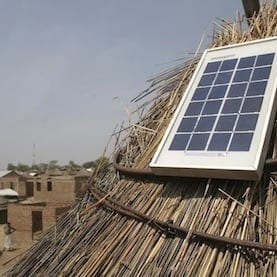
Selling solar energy on an installment plan is an affordable alternative to kerosene fuel
A creative way of selling solar energy is gaining traction in sub-Saharan Africa: customers can pay as they go.
Only one in six rural inhabitants in sub-Saharan Africa has access to electricity. For households living off the grid, kerosene lamps are the primary lighting source—an expensive technology that is also unsafe, because kerosene is flammable as well as poisonous when inhaled or ingested. TheWorld Bank estimates that breathing kerosene fumes is the equivalent of smoking two packs of cigarettes a day, and two thirds of adult females with lung cancer in developing nations are nonsmokers. “The poorest people in the world are not just paying a bit more for their energy, they’re paying a disproportionate amount”, says Simon Bransfield-Garth, CEO of Azuri Technologies, a solar services firm based in Cambridge, England.
Across the U.S. and U.K. electricity from a utility costs between 10 to 15 cents per kilowatt-hour (kWh). A villager in rural Kenya or Rwanda, however, pays an equivalent cost of $8 per kWh for kerosene lighting. Often 30 percent or more a family’s income is spent on kerosene. Charging a mobile phone is even more expensive. That same villager would pay nearly 400 times more to charge a mobile phone in rural Kenya than in the U.S. Solar-powered charger kits are a promising alternative, but many rural families cannot afford the up-front cost of these systems, which start at $50.
With a Pay-As-You-Go model (PAYG) for solar kits, on the other hand, customers can instead pay an up-front fee of around $10 for a solar charger kit that includes a two- to five-watt solar panel and a control unit that powers LED lights and charges devices like mobile phones. Then they pay for energy when they need it—frequently in advance each week—or when they can (say, after a successful harvest). In practice, kits are paid off after about 18 months and subsequent electricity is free to the new owner. PAYG customers are finding that instead of paying $2 to $3 a week for kerosene, they pay less than half that for solar energy. The PAYG concept is a familiar one for hundreds of millions of Africans who purchase mobile phone minutes and kerosene fuel incrementally.
The Latest Google Headlines on:
Pay-as-You-Go Solar
[google_news title=”” keyword=”Pay-as-You-Go Solar” num_posts=”10″ blurb_length=”0″ show_thumb=”left”]
The Latest Bing News on:
Pay-as-You-Go Solar
- Power Up Anywhere With These Solar Chargerson May 2, 2024 at 6:03 am
Pack a solar charger for the trip and suddenly you’ve got the world back at your fingertips. These portable gadgets marry solar panels with battery packs—they’re small and lightweight enough to not ...
- 6 Things To Consider Before Installing Solar Panels At Your Rental Property Or Homeon April 28, 2024 at 6:45 pm
Installing a solar system at your rental property can reduce energy costs for your renters and potentially create a surplus of energy to be used later.
- What Is Solar Leasing? Here’s What You Should Knowon April 23, 2024 at 3:37 pm
Any tax breaks offered go to the solar developer, not the homeowner ... installs the solar panel system on your roof, and then you pay that party for your energy each month.
- How Much Do Solar Panels Cost In 2024?on April 15, 2024 at 11:19 pm
Still, if you’re on the go, we believe thin-film solar panels ... the more you’ll pay. “Does the solar system size refer to the output capacity of the DC PV system or the inverter system ...
- Should You Go Solar if You Live on the East Coast? What You Need to Knowon April 8, 2024 at 9:27 pm
The sun shines on the entire East Coast, but certain states have better incentives for rooftop solar panel system owners. Here's how to know if you live in one of them. Rooftop solar keeps setting ...
- Should You Buy Solar Panels or Rent Them?on March 10, 2024 at 9:58 am
When you buy a solar system for your home, you have to pay for (or finance) the entire cost of the installation, and the panels and equipment belong to you. "If you buy panels, you own the system ...
- How do solar panels work? Your renewable energy system explainedon February 24, 2024 at 5:06 pm
However, more states are moving away from retail-rate net metering to programs that don’t pay you as much for the power your solar panels generate. If you live in a state with one of these ...
- Everything you need to know about the types of solar batterieson February 20, 2024 at 12:10 pm
Getting batteries installed at the same time you go solar lets you apply that 30% tax credit to the cost of the batteries as well, which you can’t do if you later decide you want batteries.
- The Pros and Cons of Solar Panels: Are They Worth It?on December 8, 2023 at 9:12 am
Another reason now is a good time to go solar, as Burke said ... determining how much you hope to save or how long you want to take to pay them off. If you're going totally off-grid, it's helpful ...
- How Much Do Solar Panels Cost in Texas? (2024)on July 12, 2023 at 2:09 pm
Leonardo David is an electromechanical engineer, MBA, energy consultant and technical writer. His energy-efficiency and solar consulting experience covers sectors including banking, textile ...
The Latest Google Headlines on:
Solar energy
[google_news title=”” keyword=”solar energy” num_posts=”10″ blurb_length=”0″ show_thumb=”left”]
The Latest Bing News on:
Solar energy
- Tigo Energy launches home solar-plus-storage solution for Puerto Ricoon May 2, 2024 at 2:00 am
Installed in Arecibo, the system was designed and installed by local Tigo partner CEnergyS Solar Solutions. #NewsismyBusiness ...
- New metallization tech for HJT solar cells minimizes silver use, increases efficiencyon May 2, 2024 at 1:58 am
German research institute Fraunhofer ISE has unveiled a new metallization process for heterojunction solar cells that reportedly increases power conversion efficiencies by over 0.1% while reducing ...
- Nigeria: Solar energy drives greater efficiency at healthcare centreson May 2, 2024 at 12:53 am
The solar systems help power ventilators, refrigerators for storing vaccines, medications and other cold chain medications.
- Bloomington Planning Commission OKs zoning, annexation of proposed solar energy siteon May 1, 2024 at 8:46 pm
BLOOMINGTON — Zoning and annexation of a 132-acre lot in west Bloomington intended for a 5-megawatt solar project was recommended by the Planning Commission on Wednesday.
- Is solar energy the way to go?on May 1, 2024 at 5:00 pm
Yes, the materials needed to make panels and batteries have a negative carbon footprint, but the benefits of clean solar energy far outweigh the initial environmental effects of their production. The ...
- Philly announces next big solar energy project, which could power 600 city-owned buildingson May 1, 2024 at 7:04 am
Either solar, wind, or hydroelectric could be the next big source of renewable power for Philadelphia's municipally-owned buildings.
- Scientists make breakthrough while investigating potential of solar panels: 'We figured some other ways to capture more solar energy'on May 1, 2024 at 4:15 am
Scientists have been hard at work figuring out ways to make solar cells — the part of the solar panel that actually absorbs light — work more efficiently. However, a group of scientists working on ...
- Solar energy in Indiana remains a contentious topicon April 30, 2024 at 5:00 pm
The sun is estimated to be 4.5 billion years old. Its rays make life on earth possible, and they can also be used for energy, including in Indiana. In October 2023, Canadian Solar announced the future ...
- The ROI of solar: Why Austin businesses are investing in renewable energyon April 30, 2024 at 5:00 pm
For businesses considering renewable energy, Austin Energy’s solar solutions offer a compelling case. It’s not just about being green; it’s about embracing a sustainable future that benefits everyone ...
- $500 million for solar energy for tribal familieson April 29, 2024 at 6:39 am
Look for solar panels to blossom atop low-income homes in Indian Country over the next five years. Last week, the Environmental Protection Agency announced $500 million for tribes as part of $7 ...










